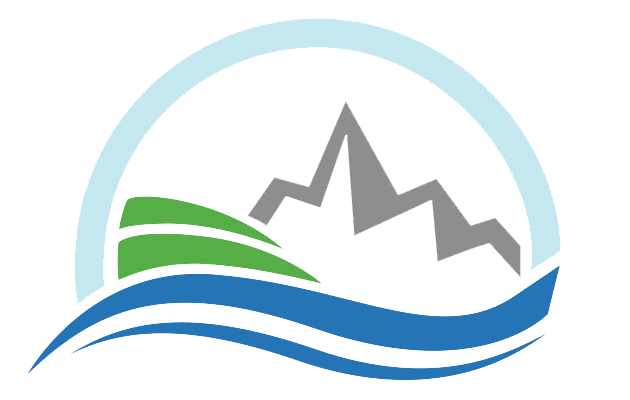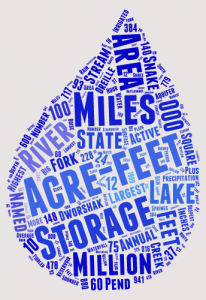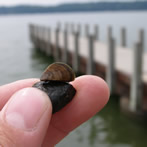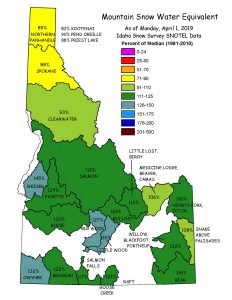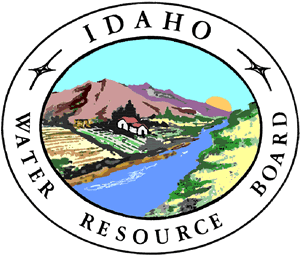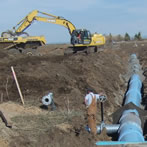- Preserving lake levels through the main recreation season. This goal supports the local economy and meets current lake level requirements. It also avoids any negative impacts to downstream river flows.
- Maintaining vessel access through the Thorofare channel between Upper Priest Lake and Priest Lake.
The Priest Lake Water Management Study was initiated by the IWRB to evaluate opportunities for improving operation of the Priest Lake (also known as Lower Priest Lake) and Priest River system. The study includes several action items.
- Evaluation of alternatives for maintaining required recreational lake levels and maintaining current minimum discharge requirements downstream of the Priest Lake Outlet Dam (60 cfs).
- Assessing potential structural and operational modifications to the dam.
- Analyzing options to improve access and navigable conditions for the Priest Lake Thorofare.
Priest Lake is approximately 18 miles long, has a maximum depth greater than 300 feet, and has an active storage capacity of approximately 76,000 acre-feet. It is connected to Upper Priest Lake (which is approximately 3.3 miles long) by a three-mile long channel known as the “Thorofare,” which has long been used by the public for recreation and access to the upper lake. A 1,400-foot-long timber breakwater at the north end of Priest Lake is intended to manage sediment from the upper lake while providing wave and erosion protection to landowners at the north end of Priest Lake.
Priest Lake Outlet Dam was constructed in 1950 to maintain lake levels in Priest Lake and manage downstream flows into Priest River. The current Priest Lake Outlet Dam, which was constructed in 1978, is owned by IDWR and operated by a contractor on behalf of IDWR. The dam is approximately 12 feet high with gates that regulate discharge. It does not have an emergency spillway.
For a printable map and photos of the area, visit the Map & Images page.
IWRB is committed to meaningful participation by all stakeholders in the decision-making process. Throughout the study (approximately 10 months), you will have ongoing opportunities to respond and comment on any options that might be developed. You are encouraged to visit this project website to learn more information about the project, public information meeting dates, opportunities for public comment, and other ways you can stay informed about the project during the study process. We encourage you to contact the Project Team at any time with your questions and comments.
Upon construction of the Priest Lake Outlet Dam in 1950, the State of Idaho and Northern Lights, Inc., the operator of the dam, executed an operations and maintenance agreement which stipulates that the minimum discharge from the Priest Lake Outlet Dam during the recreation season shall be 60 cfs. Since the execution of the operations and maintenance agreement, IDWR has operated the dam to meet the minimum discharge flow of 60 cfs.
In 1927, Water Right License No. 16642, which was amended to Water Right 97-2020, was issued to the State of Idaho for preservation of said water in lake (Priest Lake) for scenic beauty, health, and recreation purposes necessary and desirable for all inhabitants of the State. The priority date for the water right is January 24, 1927, with a beneficial use designation of “Recreation Storage,” with a storage volume of 800,000 acre-feet. As stated in the original license, the 800,000 acre-feet is needed to maintain the level of Priest Lake not higher than normal high-water stage and not lower than the natural low-water stage at any season of the year.
In accordance with Idaho Code § 70-507, the dam is operated to maintain the lake levels at 3.0 feet on the Priest Lake at Outlet Near Coolin ID gage (USGS No. 12393000) for recreational purposes.
The Priest Lake Water Management Study was initiated by the IWRB to evaluate conceptual alternatives for accomplishing the objectives of the study:
- Preserving lake levels through the main recreation season. This goal supports the local economy and meets current lake level requirements. It also avoids any negative impacts to downstream river flows.
- Maintaining vessel access through the Thorofare channel between Upper Priest Lake and Priest Lake.
Upon completion of the study, the IWRB will select a preferred alternative. Once a preferred alternative is selected, a detailed lake operations plan will be developed by IDWR in coordination with the IWRB and stakeholders.
A detailed Lake Operations Plan is outside the scope of the current study. The Priest Lake Water Management Study will evaluate conceptual alternatives. Once a preferred conceptual alternative is selected by the IWRB, a detailed lake operations plan will be developed by IDWR in coordination with the IWRB and stakeholders.
No. Any action on the cold-water-siphon concept would take place after completion of the Priest Lake Water Management Study.

